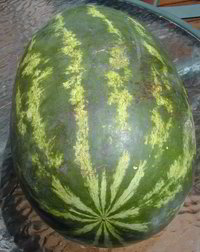| Watermelon | ||||||||||||||
|---|---|---|---|---|---|---|---|---|---|---|---|---|---|---|
| Scientific classification | ||||||||||||||
|
Watermelon (Citrullus lanatus, Family Cucurbitaceae) is the fruit and plant of a vine-like (climber and trailer) herb originally from southern Africa. David Livingstone, the African explorer, described watermelon as abundant in the Kalahari Desert, where it grows wild and is known as the Tsamma melon. This flowering plant bears an accessory fruit of a type that botanists call a false berry. The watermelon fruit, loosely considered a type of melon (although not in the Genus Cucumis), has a smooth exterior rind and a moist, sweet, usually red interior flesh. The species descriptor Citrullus vulgaris is sometimes, synonymously, used to refer to this plant (vulgaris, meaning "common" - Shosteck, 1974).
Agricultural aspects in the United States
Until the 1940s, the watermelon was rarely found in a grocery. Melon lovers had to grow their own, which tended not to keep for long. Then a USDA plant breeder set out to produce a better watermelon. The result was "that gray melon from Charleston," formally called the Charleston Gray. Its oblong shape and hard rind made it easy to stack and ship. Its adaptability meant it could be grown over a wide geographical area. It produced high yields and was resistant to the most serious watermelon diseases: anthracnose and fusarium wilt. Best of all, it tasted terrific. Today, almost all commercial watermelon varieties have some Charleston Gray in their lineage.
This now common watermelon is large enough that groceries often sell half or quarter melons. There are also some smaller, spherical varieties of watermelon, both red- and yellow-fleshed. So-called "seedless" watermelons have far fewer, and softer, seeds than average, but generally contain at least a few pale seeds.
Compared with most fruits, the watermelon has a very high water content, and can be used to satisfy thirst. Watermelons seeds are roasted by Asians. Pickling watermelons is widespread in Russia, and pickled watermelon rind is also popular in the West.
For commercial plantings, one bee hive per acre (4,000 m² per hive) is the minimum recommendation by the US Department of Agriculture for pollination of conventional seeded varieties. Seedless hybrids have sterile pollen and pollinizer rows of varieties with viable pollen must also be planted, and the pollinator density increased to three hives per acre (1,300 m² per hive).

